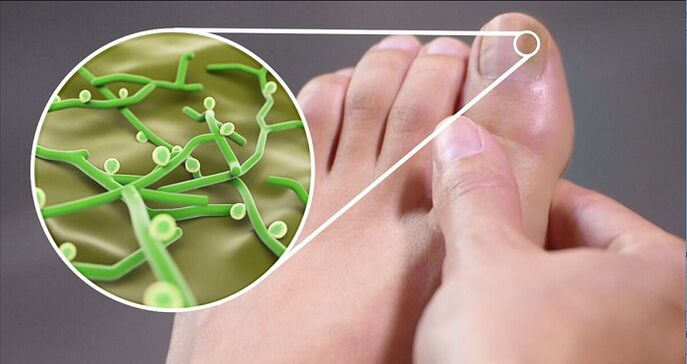Few people know what ringworm looks like, although this type of infection is widespread. Due to a lack of knowledge, many people confuse a fungal infection with a common allergic or allergic reaction, so they begin treatment at the terminal stage as the disease progresses. Fungal infections are reversible, according to statistics, 20% of the total population is susceptible to fungal infections.
What does a fungal infection look like?
Fungi are infectious diseases that affect the skin, mainly on the feet. There are several types of diseases, but the most common is fungal disease. The mushroom is resilient, it is adaptable to almost any condition. Even when a person recovers from the illness, relapses are usually unavoidable, as the fungal spores continue to live in clothing and shoes. In most cases, the fungal disease affects the nail plates and the skin of the feet.
Few people know what foot fungus looks like. Fungi come in several varieties, each with its own symptoms and manifestations:
- the first stage of the fungus is manifested by redness, swelling and small nodules;
- the fungus continues to progress, sloughing off the skin and becoming red, pink bumps;
- If the disease is not treated properly, the fungus spreads to the nail sheets, changing their color, shape and structure.
The final stage is characterized by desquamation of the skin, as well as the appearance of deep cracks that cause pain and bleeding. At all stages of development, the fungus of the toes exhibits an unpleasant, itchy manifestation. To accurately describe the appearance of the disease, just look at the pictures on the subject.

Fungal infection process
Fungi affect people regardless of their age and occupational activity. It is very contagious (especially when wearing someone else's shoes). You can also become infected in public places such as bathtubs, saunas, and swimming pools. When entering the skin, the fungus gradually begins to destroy the nail plate, while also moving around the body. That is why the severe stage of the disease uses only complex therapy (creams, ointments, drops and pills).
The risk group for fungal infections includes several types of people:
- employees of enterprises taking baths together after work shift;
- professional people engaged in sports;
- soldiers (mostly sailors);
- utility workers;
- miner.
Fungal infections quite often affect housewives and those with specialized tasks directly related to water.

Fungal skin: diagnosis and treatment
After learning what the fungus on the feet looks like, you can immediately identify it. But self-medication in this case is not suitable, because initially it is necessary to determine the type of pathogen and its form. This can only be done in a medical setting. If a person, by external signs, suspects he has fungal skin conditions, then he or she should urgently see a dermatologist.
Specialist doctors necessarily conduct initial examination for patients, do necessary tests (complete blood count, microscopy). If the diagnosis is confirmed, then the person will be assigned the necessary treatment. These can be creams, ointments, and oral tablets. Only the doctor decides how to treat the disease, should not prescribe an antifungal for yourself.

Folk remedies
At the initial stage of the onset or in addition to drug treatment, traditional medicine is perfect. There are several ways to get rid of foot fungus. To treat ringworm, prepare a tincture or chamomile. To do this, you need to take 2 tablespoons. l herbs and pour 200 ml of boiling water. The alcohol must be allowed to cool, pour into a basin and lower the legs there for 15-20 minutes. Then, use a tissue to clean your feet and apply black birch, paying special attention to the damaged skin. The procedure must be repeated daily until the signs of the disease disappear completely.
If the nail plates have been affected by fungus, then the treatment will take longer. In traditional medicine, iodine and 9% vinegar are most commonly used. The liquid must be combined in equal proportions and the affected nails must be lubricated with the resulting medication. In this case, you should cut the nail as much as possible.
Folk remedies are very effective in some cases. However, it is not recommended to use them at an advanced stage of the disease, when the fungal infection has entered the bloodstream. In this case, it is better to seek help from a specialist who can advise not only competent but also safe treatment.
Skin fungus does not significantly harm human health but often causes discomfort, as the diseased skin and fingernails do not look very attractive. The presence of such a disease prevents a person from accessing public places (swimming pools, saunas, water parks), despite the fact that in these settings, infectious diseases are common. As a precaution, you must follow the rules of personal hygiene and monitor your health.



























